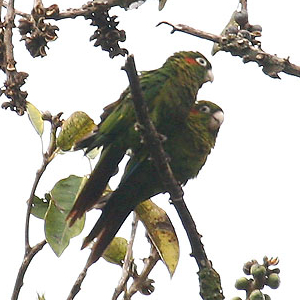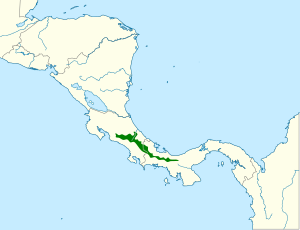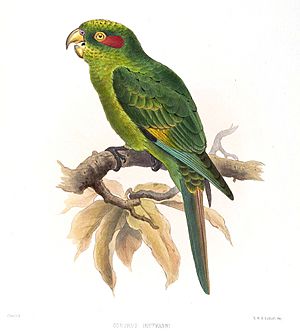Sulphur-winged parakeet facts for kids
Quick facts for kids Sulphur-winged parakeet |
|
|---|---|
 |
|
| In Costa Rica | |
| Conservation status | |
| Scientific classification | |
 |
The sulphur-winged parakeet (Pyrrhura hoffmanni) is a colorful bird. It is a type of parrot found in the forests of Costa Rica and Panama. People who keep birds sometimes call it Hoffmann's conure.
Contents
About the Sulphur-winged Parakeet
What is its scientific name?
The sulphur-winged parakeet has two main types, called subspecies. The first one is P. h. hoffmanni. This is the original type that scientists first described. The second type is P. h. gaudens.
This bird is named after a German scientist named Karl Hoffmann.
What does it look like?
The sulphur-winged parakeet is about 23 to 24 centimeters (9 to 9.4 inches) long. It weighs around 82 grams (2.9 ounces). Both male and female birds look the same.
Most of their body is green. Their head, neck, and throat have some yellow feathers mixed in. They have white skin around their eyes. The feathers near their ears are a bright orange-red color. Their chest has a light orange shade.
Their wings are mostly green. Some feathers on their wings are yellow, and the outer ones are blue. The top of their tail is a reddish-brown olive color. The underside of their tail is reddish-brown.
Young birds have duller colors. They have less orange on their chest and less yellow on their wings. The P. h. gaudens subspecies has some orange-red marks on its head. Its belly feathers are a bit darker.
Where does it live?
The main type of sulphur-winged parakeet lives in the Cordillera de Talamanca mountains. It also lives in the Dota region of southern Costa Rica. The P. h. gaudens subspecies lives in western Panama. It can be found as far east as Veraguas Province.
These parakeets live in old mountain forests. They also live in forests that have been cut down and are growing back. You can find them in bushy areas too. They usually live at high places, from 700 to 3000 meters (2,300 to 9,800 feet) high. Most often, they are found above 1600 meters (5,200 feet).
Sulphur-winged Parakeet Behavior
How does it move?
The sulphur-winged parakeet moves between high and low places. During the rainy season, they fly to lower elevations. They also make daily trips between where they sleep and where they eat.
What does it eat?
These parakeets usually look for food in small groups. They search in the tops of trees. They mostly eat fruits and seeds from different plants and trees.
Reproduction and Life Cycle
Sulphur-winged parakeets likely build their nests between January and June. They make their nests in natural holes in trees. They also use old holes made by woodpeckers. These nests are usually high up, about 8 to 20 meters (26 to 66 feet) above the ground.
In places where they are cared for by humans, they lay about six eggs. The eggs hatch after 24 days. The young birds are ready to fly about 10 weeks after they hatch.
What do its calls sound like?
The most common sound the sulphur-winged parakeet makes is a series of high-pitched, sharp notes. It sounds like "krree krree krree". They make this sound when they are sitting on a branch and when they are flying. Their calls are sharp but not harsh.
When they are sitting, they are often quiet. But when flocks of these birds fly together, they call often. They make a loud, noisy, and piercing chattering sound.
Status of the Sulphur-winged Parakeet
Is it an endangered bird?
The IUCN (International Union for Conservation of Nature) says the sulphur-winged parakeet is a species of "Least Concern". This means it is not currently in danger of disappearing.
Even though it lives in a small area, there are many of them. Scientists think there are between 20,000 and 50,000 adult birds. This number seems to be staying steady.
No big threats have been found for this bird. It is quite common in its home range. It can also live in areas where the forest has changed a lot. The pet trade does not seem to affect it much either.
See also
 In Spanish: Perico de Hoffman para niños
In Spanish: Perico de Hoffman para niños



